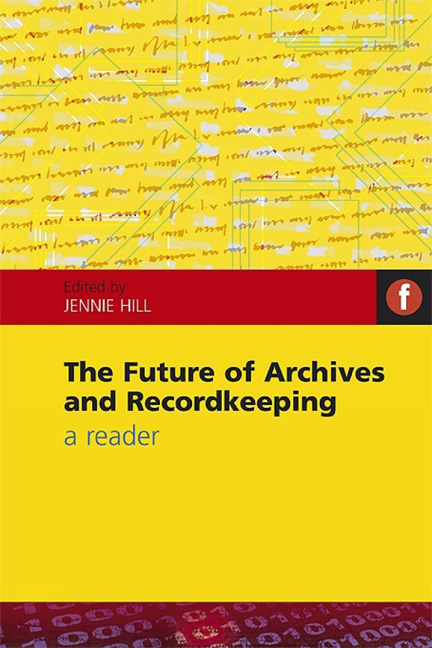Book contents
- Frontmatter
- Dedication
- Contents
- Acknowledgements
- Contributors
- Introduction: seeing the future of archives and recordkeeping
- Part 1 Defining archives
- 1 Where do we come from? What are we? Where are we going? Situating the archive and archivists
- 2 Encounters with the self: archives and research
- 3 Strangely unfamiliar: ideas of the archive from outside the discipline
- Part 2 Shaping a discipline
- Part 3 Archive 20: archives in society
- Part 4 Archives in the information age: is there still a role for the archivist?
- Index
- Miscellaneous Endmatter
- Miscellaneous Endmatter
- Miscellaneous Endmatter
1 - Where do we come from? What are we? Where are we going? Situating the archive and archivists
from Part 1 - Defining archives
Published online by Cambridge University Press: 08 June 2018
- Frontmatter
- Dedication
- Contents
- Acknowledgements
- Contributors
- Introduction: seeing the future of archives and recordkeeping
- Part 1 Defining archives
- 1 Where do we come from? What are we? Where are we going? Situating the archive and archivists
- 2 Encounters with the self: archives and research
- 3 Strangely unfamiliar: ideas of the archive from outside the discipline
- Part 2 Shaping a discipline
- Part 3 Archive 20: archives in society
- Part 4 Archives in the information age: is there still a role for the archivist?
- Index
- Miscellaneous Endmatter
- Miscellaneous Endmatter
- Miscellaneous Endmatter
Summary
Introduction
This chapter examines archives and archivists in the context of past, present and future. It foreshadows many of the themes discussed elsewhere in this book – the growing influence of postmodernism on the profession pervades many of the chapters here, the interconnectedness of creator, user and archivist (see, for example, Breakell [Chapter 2], Theimer [Chapter 7] and Flinn [Chapter 8]), as well as the need to balance the ‘traditional’ skills with recent developments in digital technology and the place of the archivist within these changes (see, for example, Duranti [Chapter 4], Ketelaar [Chapter 5], Cunningham [Chapter 9], Convery [Chapter 10] and Cox [Chapter 11]) and the growing interest in the notion of archives from outside the discipline (Buchanan [Chapter 3]). It explores the broad movement within archives from the positivist outlook, which highlighted the impartiality and transparency of the archivist, through more recent reactions to the postmodern turn in archives which has enabled us to challenge this positivist ideology and question the role of archives, archivists, users and creators in new ways, and concludes by looking at the future challenges and directions for archivists.
In the shadow of Jenkinson
Recently the subject of the archive has moved from obscurity to prominence in both the academy and society at large. This interest has not come from inside the discipline but rather from outside. Tom Nesmith has characterized this as bringing archivists ‘to a major turning point in the intellectual history of their profession’ (2005, 260) and indeed archivists in Canada, Australia, South Africa and latterly America have taken up the challenge of the fundamental reconstruction of both the archive and the archivist's identity. Within the profession in the UK there are certain noises in this direction but these are deafened by the resistance to what is seen as a dangerous threat to the sanctity of the epistemological bedrocks of our archival practice and the traditions that were inscribed by Hilary Jenkinson (1965) in his 1922 A Manual of Archive Administration.
Hilary Jenkinson's ideology fixed the archivist's ‘career as one of service …. His Creed, the Sanctity of Evidence…. The good Archivist is perhaps the most selfless devotee of Truth the modern world produces’ (quoted in Cook, 1997, 23) and contended that archives ‘themselves state no opinion, voice no conjecture;…
- Type
- Chapter
- Information
- The Future of Archives and RecordkeepingA reader, pp. 7 - 26Publisher: FacetPrint publication year: 2010

